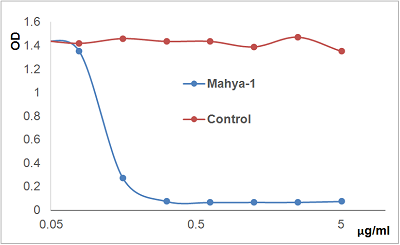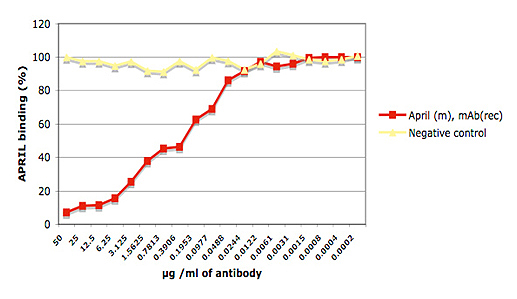
Schematic antibody structure.
anti-APRIL (mouse), mAb (rec.) (blocking) (Apry-1-1)
AG-27B-0001
ApplicationsImmunoPrecipitation, ELISA, Neutralisation/Blocking
Product group Antibodies
TargetTnfsf13
Overview
- SupplierAdipoGen Life Sciences
- Product Nameanti-APRIL (mouse), mAb (rec.) (blocking) (Apry-1-1)
- Delivery Days Customer10
- ApplicationsImmunoPrecipitation, ELISA, Neutralisation/Blocking
- CertificationResearch Use Only
- ClonalityMonoclonal
- Clone IDApry-1-1
- Concentration1 mg/ml
- Estimated Purity>95%
- Gene ID69583
- Target nameTnfsf13
- Target descriptiontumor necrosis factor (ligand) superfamily, member 13
- Target synonyms2310026N09Rik, April, Tall2, Tnlg7b, Trdl1, tumor necrosis factor ligand superfamily member 13, a proliferation-inducing ligand, tumor necrosis factor ligand 7b
- HostMouse
- IsotypeIgG2b
- Protein IDQ9D777
- Protein NameTumor necrosis factor ligand superfamily member 13
- Scientific DescriptionAPRIL is a cytokine that belongs to the TNF superfamily and binds to TACI and BCMA. It is implicated in the regulation of tumor cell growth and is involved in monocyte/macrophage-mediated immunological processes. Anti-APRIL (mouse) Monoclonal Antibody (recombinant) (Blocking) (APRY-1-1) is an antibody developed by antibody phage display technology using a human naive antibody gene library. These libraries consist of scFv (single chain fragment variable) composed of VH (variable domain of the human immunoglobulin heavy chain) and VL (variable domain of the human immunoglobulin light chain) connected by a polypeptide linker. The antibody fragments are displayed on the surface of filamentous bacteriophage (M13). This scFv was selected by affinity selection on antigen in a process termed panning. Multiple rounds of panning are performed to enrich for antigen-specific scFv-phage. Monoclonal antibodies are subsequently identified by screening after each round of selection. The selected monoclonal scFv is cloned into an appropriate vector containing a Fc portion of interest and then produced in mammalian cells to generate an IgG like scFv-Fc fusion protein. - Recombinant Antibody. Recognizes mouse APRIL. Does not recognize mouse BAFF. Species cross-reactivity: Mouse. Clone: Apry-1-1. Isotype: Mouse IgG2blambda. Applications: ELISA, FUNC (Blocking), IP. Host: Purified from HEK 293 cell culture supernatant. Liquid. In PBS containing 10% glycerol and 0.02% sodium azide. APRIL is a cytokine that belongs to the TNF superfamily and binds to TACI and BCMA. It is implicated in the regulation of tumor cell growth and is involved in monocyte/macrophage-mediated immunological processes. Anti-APRIL (mouse) Monoclonal Antibody (recombinant) (Blocking) (APRY-1-1) is an antibody developed by antibody phage display technology using a human naive antibody gene library. These libraries consist of scFv (single chain fragment variable) composed of VH (variable domain of the human immunoglobulin heavy chain) and VL (variable domain of the human immunoglobulin light chain) connected by a polypeptide linker. The antibody fragments are displayed on the surface of filamentous bacteriophage (M13). This scFv was selected by affinity selection on antigen in a process termed panning. Multiple rounds of panning are performed to enrich for antigen-specific scFv-phage. Monoclonal antibodies are subsequently identified by screening after each round of selection. The selected monoclonal scFv is cloned into an appropriate vector containing a Fc portion of interest and then produced in mammalian cells to generate an IgG like scFv-Fc fusion protein.
- Storage Instruction-20°C,2°C to 8°C
- UNSPSC12352203



